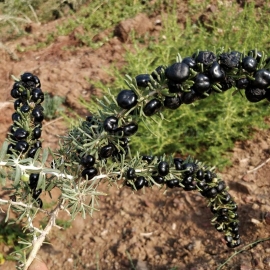 EXCLUSIVE
EXCLUSIVE







Organic black goji berry seeds (Lycium ruthenicum)
-
ORGANIC BLACK GOJI BERRY SEEDS (LYCIUM RUTHENICUM)
Shrub 20-150 cm high with multiple thorns. It forms many branches with rigid branches, often curved, white. The leaves are formed on hard branches, in groups of 2-6, fleshy, compressed and tapered, lanceolate or cylindrical, 5-30 mm long, obtuse and round.
They are located only around the stem of the flowers, with 1-2-minute thorns, 5-10 mm long, appearing on both sides of the base of the leaves. The flowers are hermaphroditic (they have both male and female organs) and are fertilized by bees and insects. The calyx is narrow, tubular, 3-4 mm long, lobed with 2-4 lobes. The inflorescence is a funnel-shaped or tubular shape with 2-3 times larger lobes, purple in color and 1 cm long. Stamens are uneven in length.
The berries are globular, dark purple until fully ripe, 4-9 mm in diameter. Seeds are reniform, brown in color. The flowering time varies from June to August, but can sometimes bloom in May. The fruits bear fruit from August to October.
Also known as: Black Wolfberry Fruit Extract, wild black wolfberry.
HOW TO GROW
Plants grown from seed are similar in appearance to tomato seedlings at first. Seedlings and young plants are likely to be variable in appearance, and can be grown in a nursery until the following year, when they can be transplanted to the field. Dormant nursery stock should be planted in spring once danger of frost is past.
Mulching after planting with an organic mulch can keep down weeds, moderate root temperatures, and promote establishment. Irrigation is highly recommended especially during the establishment year, as the root system is fine and can easily dry out, and the fruit are prone to blossom end rot under conditions of low or uneven moisture. However, overwatering should be avoided. Plants should be spaced 3 to 5 feet apart within the row and at least 6 to 8 feet between rows, though wider between-row spacing may be needed to accommodate equipment.
